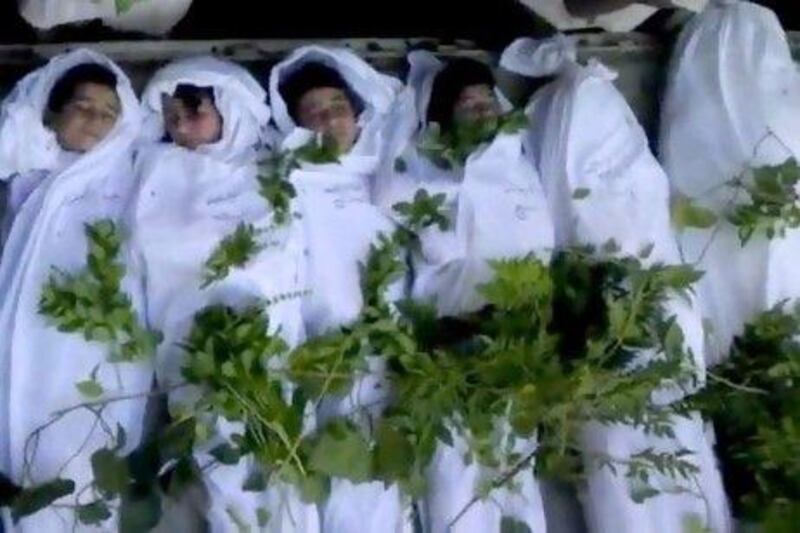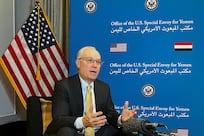DARAYA // Chickens once more turn on spits outside of Abu Kamal's, a restaurant in the centre of town and a local landmark of sorts, known for its mediocre but filling fast food.
People slowly walk in the streets, small general stores are open and some of the town's furniture makers are busy again in their small workshops, sawdust drifting out on to the roads.
It has been more than six weeks since Daraya suffered the bloodiest single massacre of the Syrian uprising, and daily life has resumed.
On the surface, little appears to have changed since the time before that bright and breezy Friday in late August, when, after a sustained artillery bombardment, tanks and ground troops moved into central Daraya and killed hundreds, perhaps a thousand, people. Men, women and children died, most of them shot.
Today, there are few overt reminders of the terror and bloodshed that ensued that day.
A car crushed by a tank stands on the side of the road. The metal shutters of shopfronts are twisted and blasted full of holes. Some cinder-block buildings bear the scars of tank fire.
Yet deeper, in the minds of its residents, Daraya is utterly changed.
"When you're out, you see people and look at their faces and maybe you think they are OK. They are pretending. Now in Daraya, people pretend to be living normal lives," said a town resident in his early 20s who is engaged to be married.
"After what happened, everyone is haunted. When you are alone, when you go to sleep at night, you cry," he said.
Chastened by the military assault - it is often referred to locally as "the scare" or "the terror" - people are still struggling to come to terms with what took place and are petrified it could happen again
Daraya's once resolute defiance of the regime - in which thousands protesting stoically, and even optimistically, endured months of shootings, mortar fire and strafing by helicopter gunships - has been profoundly shaken. It is a town still in shock.
If the goal of the assault was to make clear that continued dissent would come at a very high cost, it left no room for doubt.
"The regime had a big success with the operation. It terrified people to the extent that protests have been hard to organise now," said one leading campaigner in the town.
* * * * *
Before the raid, Daraya, a moderately wealthy town of 200,000 to 250,000 people - mainly Sunni Muslims, but with a Christian minority - was being administered with quiet efficiency by community volunteers and by a handful of local municipal officials, turning up for work out of habit. It was an undeclared liberated zone, free from government forces.
But it did not go unnoticed strategically. It is only six kilometres from the upmarket Mezze district of Damascus and adjoins Mezze Airport, a vital military facility that Daraya's rebels, growing in strength, were poised to strike.
So while few people were surprised at the fact of the late summer onslaught, its ferocity and magnitude took them aback, even in a country where atrocities and killing have become commonplace.
Before the events of August 24, the massacre of 220 people in Tremseh, in central Hama, had been the conflict's bloodiest single reported episode.
"The regime wanted to send a message that there will be huge price for defying it in Damascus, that is why it was so savage here. It was telling the people, 'If you choose the path of revolution, this is what will happen to you'," the activist said.
Underscoring their point, troops who swept through Daraya's streets wrote on walls 'Assad or No One'.
According to local activists, 673 people were slain, most of them in house-to-house raids by security forces over a 48-hour period. The government of Bashar Al Assad has provided no figures, but its version of events has it that a large number of "terrorists" - official terminology for armed rebels and those associated with the revolt - were "eliminated". Any civilian casualties were murdered by foreign-backed rebels, it said.
In Sahnaya, a largely pro-regime district neighbouring Daraya, government supporters say a thousand or more "terrorists" were killed.
Activists said they have been unable to discern a pattern to the destruction, with victims apparently chosen at random. Some troops were ruthless in killing the occupants of entire buildings and then returning to finish off survivors, they said, while some apparently conscience-stricken soldiers helped other people to safety, telling them to run for their lives.
A middle-aged father of two whose house was thoroughly ransacked, said soldiers came in and without saying a word smashed up his family's home and left.
"My name wasn't on an arrest list, they didn't ask any questions, they didn't take anything. They just broke most of what I own. They even destroyed the food I had," he said.
Looting by regime forces was nevertheless widespread, residents said, as army trucks left Daraya loaded with furniture, electrical goods and motorcycles.
According to accounts by activists and local residents, a large majority of the dead were civilians, not rebel fighters. A core of insurgents fought brief skirmishes against the better equipped and more numerous government troops, while the rest shed their weapons and escaped.
A protest organiser admitted that in the aftermath of the killings, residents turned against the opposition activists whom many in the town had previously hailed as heroes and liberators.
"The first demonstration we had after the scare, the people in the streets were shouting at us and cursed us, they said, 'Go away Free Syrian Army, leave,' and 'You, stop your demonstrations. You brought the army down on top of us.' They were angry," he said.
"After the scare, when we went out to demonstrate, we weren't sure who would kill us first, the regime troops or the people [of Daraya]," he said.
* * * * *
While Daraya is a community in shock, opponents of the regime, chronically fatigued and frustrated by the lack of practical international support for their cause, are unbowed.
The bloodshed of August dealt a setback to the opposition here, but it does not appear to have translated into a victory for Mr Al Assad's government.
Central authority has not been restored. The town's main police station, burned and riddled with gunfire during a rebel attack several months ago, is closed. There are still no traffic police or other security forces on the streets.
After the assault, just as before, there remains an uneasy standoff between encircling regime forces and encircled opposition groups.
The flag of the rebel Free Syrian Army (FSA) is still painted on town walls, so too are slogans calling for the overthrow of President Al Assad.
The insurgency was not crushed by the regime's "punishment raid" in August, said a businessman with connections to rebels in the area. "It is more or less as strong as it was before," he said.
Soldiers and secret police units are stationed on the edges of town, their tanks dug in behind high dirt fortifications. Men in sunglasses and baseball caps, clutching rifles, wait alongside pickup trucks mounted with anti-aircraft machine guns.
Sana, the state run news agency, proclaimed government troops had "cleared the town of terrorists" back in August.
Security forces at the notoriously thorough main checkpoint between Daraya and Kafa Susa do not agree.
"It's better than it was, but it's still dangerous. There are still problems. It's not safe a place, especially at night there is still fighting," said a security officer at the station, as his men inspected some cars trying to leave Daraya.
He advised the few drivers intent on taking the road through town to avoid traffic jams on the two alternative routes into Damascus, not to take the risk.
"We're protecting people, we're protecting the country against terrorists. That's the truth of the situation," he said.
* * * * *
Since the raid, activists said they have been reassessing their strategy and exploring new tactics to win over a civilian population angry at the regime and the opposition.
Security forces withdrew from the centre of Daraya a week after the August 24 assault. It took another 18 days for the first real protest to be held. Despite the absence of government troops, it is the longest period without a demonstration since Daraya joined the uprising almost from its outset 18 months ago.
"We're starting from zero again. We've got to rebuild the protest movement here," said one local dissident. "We had 100 people at a demonstration last week, much smaller than we used to have, and we are really having to talk to people to convince them to take part."
A leading opposition organiser in Daraya said the massacre had prompted deep soul-searching and had given civil society activists an opportunity to rein in armed rebel groups.
As in other parts of Syria, Daraya's uprising began with protesters calling for freedom. It was home to one of the revolt's most tireless and effective pro-democracy activists, Ghayath Matar, 26. He died last September having been shot and wounded by security agents, who then arrested him. His corpse was later returned to his family showing signs of torture.
With demonstrators being regularly killed and detained, growing numbers started to put down the roses and water they once carried as symbols of peace and picked up rifles instead.
"It is clear we made mistakes before the scare, and what happened helped us see what we were doing wrong, It made people think hard about the way we work, and if there should be a military or peaceful uprising, and what the balance of that must be," the organiser said.
In the weeks after the raid, a unified opposition council was created for the first time in Daraya, the activist said, with civilians in charge, not rebel fighters. Previously there had been separate military and civilian command structures and the two had not always seen eye-to-eye.
Splits within the opposition remain, however. A significant gap has emerged in Daraya between the young revolutionaries and older, more conservative Islamist groups, activists admitted.
The former say they want a civil, secular state aspiring to European standards of democracy, transparency and personal liberty.
"There are divisions within the revolution. Some want a real revolution, others have the same old mentality and want limited change," the organiser said.
In an effort to rebuild its battered support base, government opponents in Daraya have made the distribution of food, medical care and education for children a priority.
"We cannot just say, 'We want to topple the regime.' We must make clear what the alternative is," the organiser said. "From now on, instead of graffiti cursing the regime, our new slogans will be lessons. We will write the principles of our revolution - equality, law, nonsectarianism. We will offer a better vision of the future."
An opposition victory remained achievable in Daraya but was far from assured, the businessman close to its rebel fighters said. Since the massacre, his demeanour, once cheerful and easy-going, is now darker and more hardened.
"Our minds and hearts are still strong with the revolution, but it's possible that in the end the regime will have destroyed the whole country, there will only be the [Assad] family left, ruling an empty Syria," he said.
"Daraya is afraid the army will return and that next time it will be even worse."
psands@thenational.ae





